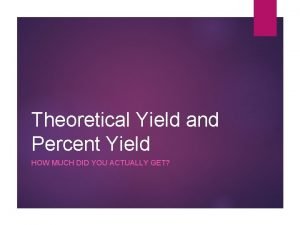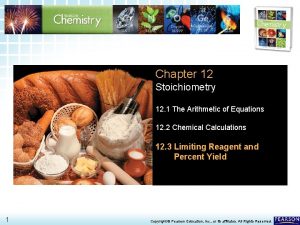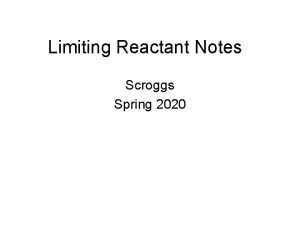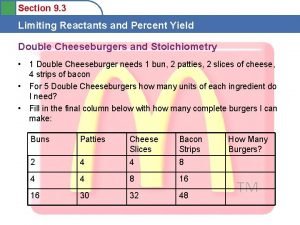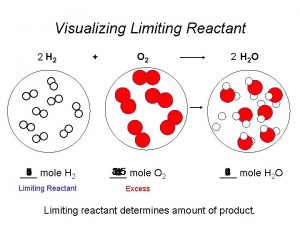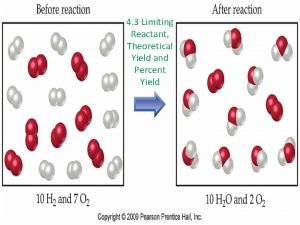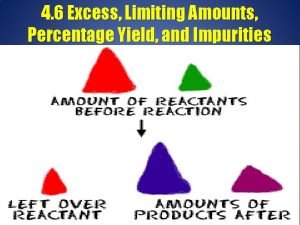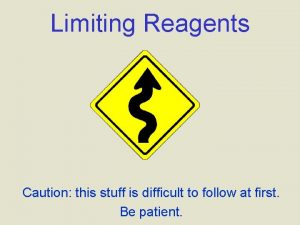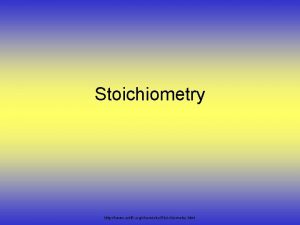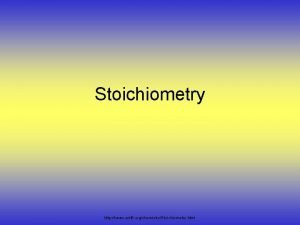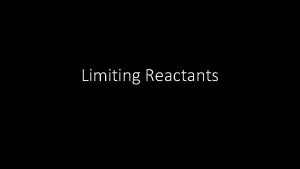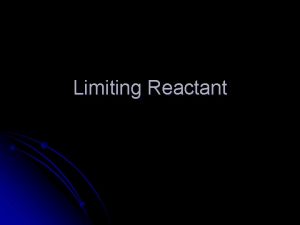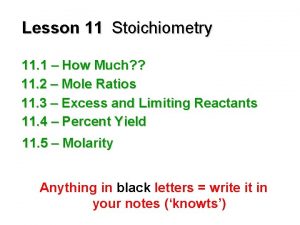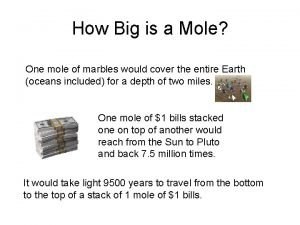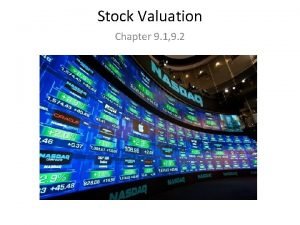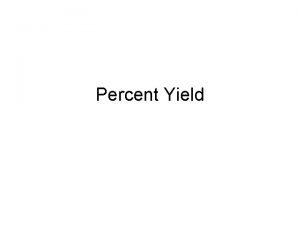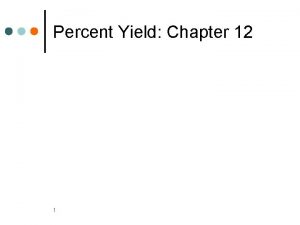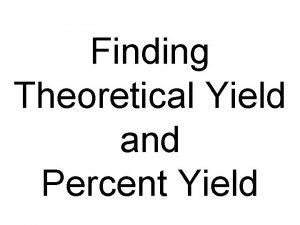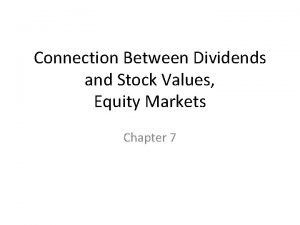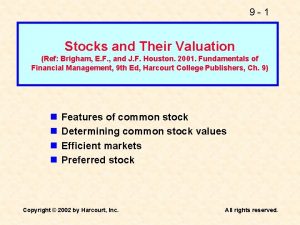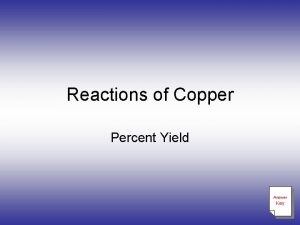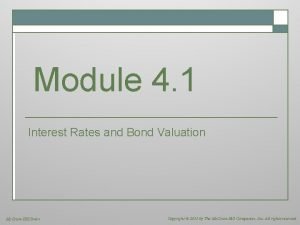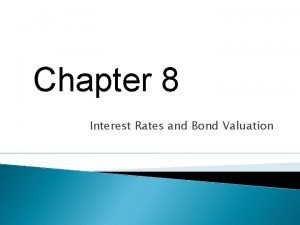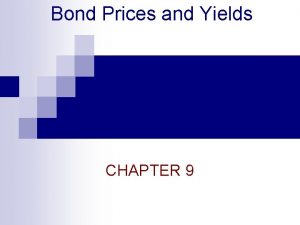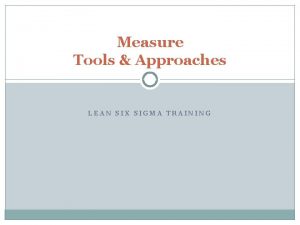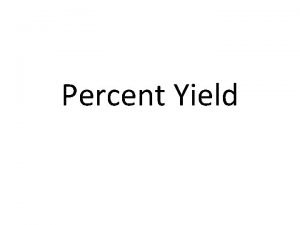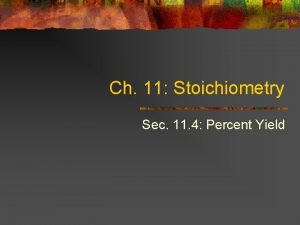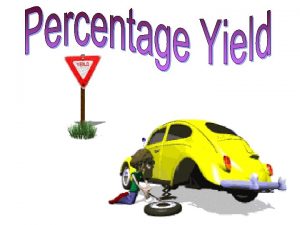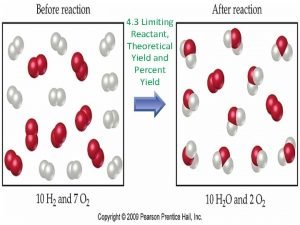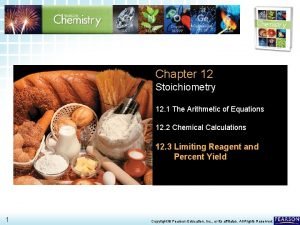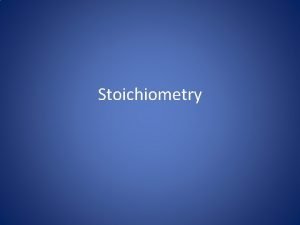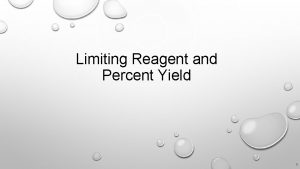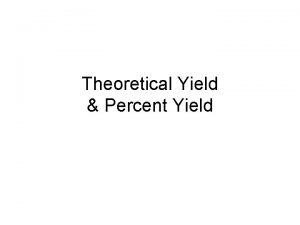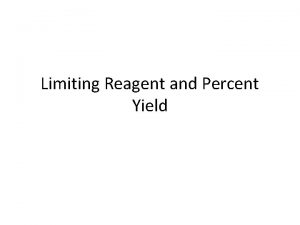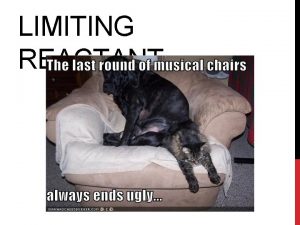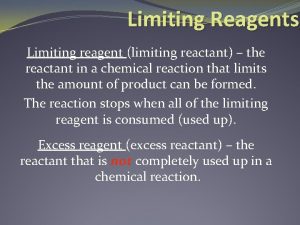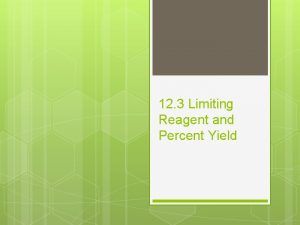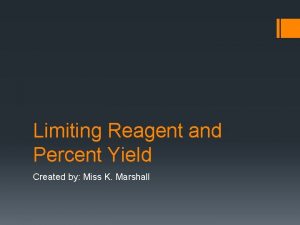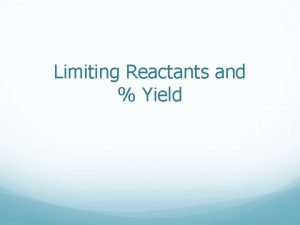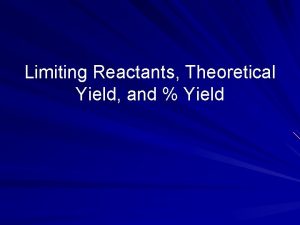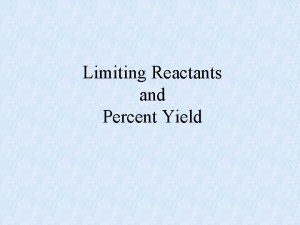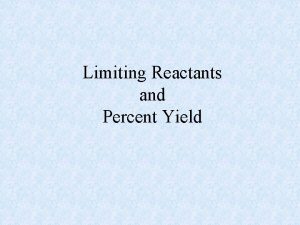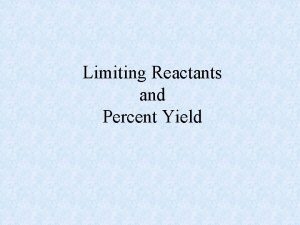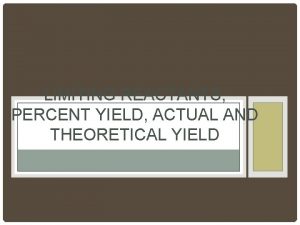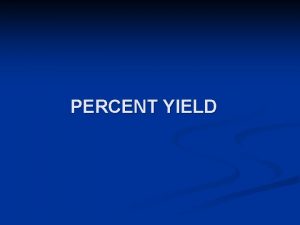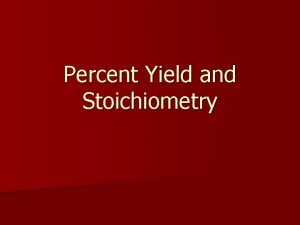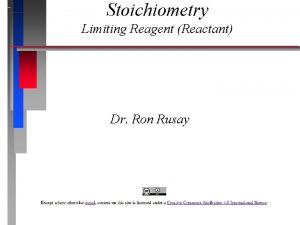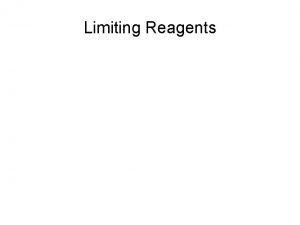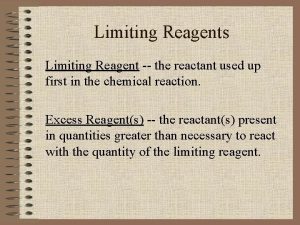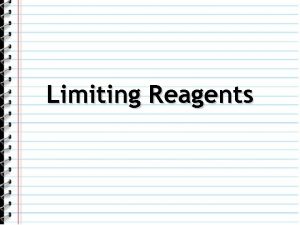12 3 Limiting Reagent and Percent Yield Chapter




































- Slides: 36

12. 3 Limiting Reagent and Percent Yield > Chapter 12 Stoichiometry 12. 1 The Arithmetic of Equations 12. 2 Chemical Calculations 12. 3 Limiting Reagent and Percent Yield 1 Copyright © Pearson Education, Inc. , or its affiliates. All Rights Reserved.

12. 3 Limiting Reagent and Percent Yield > Limiting and Excess Reagents In a chemical reaction, an insufficient quantity of any of the reactants will limit the amount of product that forms. 2 Copyright © Pearson Education, Inc. , or its affiliates. All Rights Reserved.

12. 3 Limiting Reagent and Percent Yield > Limiting and Excess Reagents A balanced chemical equation is a chemist’s recipe. Chemical Equations 3 N 2(g) + 3 H 2(g) 2 NH 3(g) “Microscopic recipe” 1 molecule N 2 + 3 molecules H 2 2 molecules NH 3 “Macroscopic recipe” 1 mol N 2 + 3 mol H 2 2 mol NH 3 Copyright © Pearson Education, Inc. , or its affiliates. All Rights Reserved.

12. 3 Limiting Reagent and Percent Yield > Limiting and Excess Reagents A balanced chemical equation is a chemist’s recipe. Chemical Equations N 2(g) + 3 H 2(g) 2 NH 3(g) “Microscopic recipe” 1 molecule N 2 + 3 molecules H 2 2 molecules NH 3 “Macroscopic recipe” 1 mol N 2 + 3 mol H 2 2 mol NH 3 • What would happen if two molecules (moles) of N 2 reacted with three molecules (moles) of H 2? Experimental Conditions Reactants Products Before reaction 2 molecules N 2 4 3 molecules H 2 0 molecules NH 3 Copyright © Pearson Education, Inc. , or its affiliates. All Rights Reserved.

12. 3 Limiting Reagent and Percent Yield > Limiting and Excess Reagents Experimental Conditions Reactants Products Before reaction 2 molecules N 2 3 molecules H 2 0 molecules NH 3 1 molecule N 2 0 molecules H 2 2 molecules NH 3 After reaction • Before the reaction takes place, N 2 and H 2 are present in a 2: 3 molecule (mole) ratio. • As the reaction takes place, one molecule (mole) of N 2 reacts with 3 molecules (moles) of H 2 to produce two molecules (moles) of NH 3. 5 Copyright © Pearson Education, Inc. , or its affiliates. All Rights Reserved.

12. 3 Limiting Reagent and Percent Yield > Limiting and Excess Reagents Experimental Conditions Reactants Products Before reaction 2 molecules N 2 3 molecules H 2 0 molecules NH 3 1 molecule N 2 0 molecules H 2 2 molecules NH 3 After reaction • All the H 2 has now been used up, and the reaction stops. • One molecule (mole) of unreacted N 2 is left in addition to the two molecules (moles) of NH 3 that have been produced by the reaction. 6 Copyright © Pearson Education, Inc. , or its affiliates. All Rights Reserved.

12. 3 Limiting Reagent and Percent Yield > Limiting and Excess Reagents Experimental Conditions Reactants Products Before reaction 2 molecules N 2 3 molecules H 2 0 molecules NH 3 1 molecule N 2 0 molecules H 2 2 molecules NH 3 After reaction • In this reaction, only the hydrogen is completely used up. • H 2 is the limiting reagent, or the reactant that determines the amount of product that can be formed by a reaction. 7 Copyright © Pearson Education, Inc. , or its affiliates. All Rights Reserved.

12. 3 Limiting Reagent and Percent Yield > Limiting and Excess Reagents Experimental Conditions Reactants Products Before reaction 2 molecules N 2 3 molecules H 2 0 molecules NH 3 1 molecule N 2 0 molecules H 2 2 molecules NH 3 After reaction • The reactant that is not completely used up in a reaction is called the excess reagent. • In this example, nitrogen is the excess reagent because some nitrogen remains unreacted. 8 Copyright © Pearson Education, Inc. , or its affiliates. All Rights Reserved.

12. 3 Limiting Reagent and Percent Yield > Steps in solving limiting reactant problems a. Write a balanced chemical equation, if necessary. b. Calculate the mass of product formed by performing a mass-mass problem for each amount of reactant given. c. Determine the limiting reactant: the reactant that produces the smallest amount of product is the limiting reagent. 9

Problems 12. 3 Limiting Reagent and Percent Yield > Limiting Reagent Practice Problems For the reaction: Na 2 O + H 2 O 2 Na. OH What weight of Na. OH could be made from 12. 4 g of Na 2 O and 42. 1 g of H 2 O 12. 4 g Na 2 O 1 mol Na 2 O 2 mol Na. OH 62 g Na 2 O 1 mol Na 2 O 40 g Na. OH 1 mol Na. OH = 16 g Na. OH 42. 1 g H 20 1 mol H 20 2 mol Na. OH 40 g Na. OH 18 g H 20 1 mol Na. OH = 187. 1 g Na. OH Na 2 O is the limiting reagent. 10

Limiting 12. 3 Limiting Reagent and Percent Yield > Reactants Problems Methyl alcohol (wood alcohol), CH 3 OH, is produced via the reaction: CO(g) + 2 H 2(g) CH 3 OH(l) A mixture of 1. 20 g H 2(g) and 7. 45 g CO(g) are allowed to react. Which reagent is the limiting reagent? 11

Limiting 12. 3 Limiting Reagent and Percent Yield > Reactants Problems CO + 2 H 2 CH 3 OH 1. 2 g H 2 1 mol H 2 1 mol CH 3 OH 2 g H 2 2 mol H 2 = 9. 6 g CH 3 OH 32 g CH 3 OH 1 mol CH 3 OH 7. 45 g CO 1 mol CH 3 OH 28 g CO 1 mol CO = 8. 52 g CH 3 OH 32 g CH 3 OH 1 mol CH 3 OH The limiting reactant is CO 12

Limiting 12. 3 Limiting Reagent and Percent Yield > Reactants Problems How much of the excess reactant (H 2) is left over? This amount is determined by calculating the amount of H 2 that would react with 7. 45 grams of CO (The amount of the limiting reactant. ) and subtracting this from starting amount of H 2. 13

Limiting 12. 3 Limiting Reagent and Percent Yield > Reactants Problems 7. 45 g CO 1 mol CO 2 mol H 2 2 g H 2 28 g CO 1 mol H 2 = 1. 06 g H 2 1. 2 g H 2 - 1. 06 g H 2 =. 14 g H 2 is left over 14

12. 3 Limiting Reagent and Percent Yield > Rust forms when iron, oxygen, and water react. One chemical equation for the formation of rust is 2 Fe + O 2 + 2 H 2 O 2 Fe(OH)2 If 7. 0 g of iron and 9. 0 g of water are available to react, which is the limiting reagent? 15 Copyright © Pearson Education, Inc. , or its affiliates. All Rights Reserved.

12. 3 Limiting Reagent and Percent Yield > Rust forms when iron, oxygen, and water react. One chemical equation for the formation of rust is 2 Fe + O 2 + 2 H 2 O 2 Fe(OH)2 If 7. 0 g of iron and 9. 0 g of water are available to react, which is the limiting reagent? How much Fe(OH)2 will be produced. 7. 00 g Fe 9. 00 g H 2 O 1 mol Fe 55. 85 g Fe 1 mol H 2 O 18. 0 g H 2 O 89. 9 Fe(OH)2 2 mol Fe 1 mol Fe(OH)=2 11. 27 g Fe(OH)2 2 mol H 2 O 89. 9 Fe(OH)2 1 mol Fe(OH)2 =45. 0 g Fe(OH)2 Fe is the limiting reagent. 16 Copyright © Pearson Education, Inc. , or its affiliates. All Rights Reserved.

12. 3 Limiting Reagent and Percent Yield > Percent Yield What does the percent yield of a reaction measure? 17 Copyright © Pearson Education, Inc. , or its affiliates. All Rights Reserved.

12. 3 Limiting Reagent and Percent Yield > Percent Yield What does the percent yield of a reaction measure? • A batting average is actually a percent yield. 18 Copyright © Pearson Education, Inc. , or its affiliates. All Rights Reserved.

12. 3 Limiting Reagent and Percent Yield > Percent Yield When a balanced chemical equation is used to calculate the amount of product that will form during a reaction, the calculated value represents theoretical yield. 19 Copyright © Pearson Education, Inc. , or its affiliates. All Rights Reserved.

12. 3 Limiting Reagent and Percent Yield > Percent Yield When a balanced chemical equation is used to calculate the amount of product that will form during a reaction, the calculated value represents theoretical yield. • The theoretical yield is the maximum amount of product that could be formed from given amounts of reactants. • The amount of product that actually forms when the reaction is carried out in the laboratory is called the actual yield. 20 Copyright © Pearson Education, Inc. , or its affiliates. All Rights Reserved.

12. 3 Limiting Reagent and Percent Yield > Percent Yield The percent yield is the ratio of the actual yield to theoretical yield expressed as a percent. actual yield percent yield = 100% theoretical yield Because the actual yield of a chemical reaction is often less than theoretical yield, the percent yield is often less than 100%. 21 Copyright © Pearson Education, Inc. , or its affiliates. All Rights Reserved.

12. 3 Limiting Reagent and Percent Yield > Percent Yield The percent yield is a measure of the efficiency of a reaction carried out in the laboratory. 22 Copyright © Pearson Education, Inc. , or its affiliates. All Rights Reserved.

12. 3 Limiting Reagent and Percent Yield > Percent Yield The percent yield is a measure of the efficiency of a reaction carried out in the laboratory. The mass of one of the products, the actual yield, is measured. The percent yield is calculated. The mass of the reactant is measured. The reactant is heated. 23 Copyright © Pearson Education, Inc. , or its affiliates. All Rights Reserved.

12. 3 Limiting Reagent and Percent Yield > Percent Yield Many factors cause percent yields to be less than 100%. • Reactions do not always go to completion; when a reaction is incomplete, less than the calculated amount of product is formed. • Impure reactants and competing side reactions may cause unwanted products to form. • Actual yield can be lower than theoretical yield due to a loss of product during filtration or in transferring between containers. • If reactants or products have not been carefully measured, a percent yield of 100% is unlikely. 24 Copyright © Pearson Education, Inc. , or its affiliates. All Rights Reserved.

12. 3 Limiting Reagent and Percent Yield > Sample Problem 12. 10 Calculating the Theoretical Yield of a Reaction Calcium carbonate, which is found in seashells, is decomposed by heating. The balanced equation for this reaction is D Ca. CO 3(s) Ca. O(s) + CO 2(g) What is theoretical yield of Ca. O if 24. 8 g Ca. CO 3 is heated? 25 Copyright © Pearson Education, Inc. , or its affiliates. All Rights Reserved.

12. 3 Limiting Reagent and Percent Yield > Sample Problem 12. 10 2 Calculate Solve for the unknown. Perform a Mass-Mass problem to calculate theoretical yield 1 mol Ca. CO 3 1 mol Ca. O 56. 1 g Ca. O 24. 8 g Ca. CO 3 100. 1 g Ca. CO 1 mol Ca. O 3 3 If there is an excess of a reactant, then there is more than enough of that reactant and it will not limit the yield of the reaction. 26 = 13. 9 g Ca. O Copyright © Pearson Education, Inc. , or its affiliates. All Rights Reserved.

12. 3 Limiting Reagent and Percent Yield > Sample Problem 12. 11 Calculating the Percent Yield of a Reaction What is the percent yield if 13. 1 g Ca. O is actually produced when 24. 8 g Ca. CO 3 is heated? Calculate theoretical yield first. Then you can calculate the percent yield. D Ca. CO 3(s) Ca. O(s) + CO 2(g) 27 Copyright © Pearson Education, Inc. , or its affiliates. All Rights Reserved.

12. 3 Limiting Reagent and Percent Yield > Sample Problem 12. 11 2 Calculate Solve for the unknown. Substitute the values for actual yield and theoretical yield into the equation for percent yield. 13. 1 g Ca. O percent yield = 100% = 94. 2% 13. 9 g Ca. O 28 Copyright © Pearson Education, Inc. , or its affiliates. All Rights Reserved.

12. 3 Limiting Reagent and Percent Yield > Sample Problem 12. 11 3 Evaluate Does the result make sense? • In this example, the actual yield is slightly less than theoretical yield. • Therefore, the percent yield should be slightly less than 100%. 29 Copyright © Pearson Education, Inc. , or its affiliates. All Rights Reserved.

12. 3 Limiting Reagent and Percent Yield > Carbon tetrachloride, CCl 4, is a solvent that was once used in large amounts in dry cleaning. One reaction that produces carbon tetrachloride is CS 2 + 3 Cl 2 CCl 4 + S 2 Cl 2 What is the percent yield of CCl 4 if 617 kg is produced from the reaction of 312 kg of CS 2? (Assume Cl 2 is in excess. ) 30 Copyright © Pearson Education, Inc. , or its affiliates. All Rights Reserved.

12. 3 Limiting Reagent and Percent Yield > What is the percent yield of CCl 4 if 617 kg is produced from the reaction of 312 kg of CS 2? CS 2 + 3 Cl 2 CCl 4 + S 2 Cl 2 3. 12 105 g CS 2 1 mol CS 2 1 mol CCl 4 76. 142 g CS 2 1 mol CS 2 153. 81 g CCl 4 1 mol CCl 4 = 6. 30 105 g CCl 4 = 630 kg CCl 4 617 kg CCl 4 Percent yield = 100% = 97. 9% 630 kg CCl 4 31 Copyright © Pearson Education, Inc. , or its affiliates. All Rights Reserved.

12. 3 Limiting Reagent and Percent Yield > Key Concepts and Key Equation In a chemical reaction, an insufficient quantity of any of the reactants will limit the amount of product that forms. The percent yield is a measure of the efficiency of a reaction performed in the laboratory. actual yield percent yield = 100% theoretical yield 32 Copyright © Pearson Education, Inc. , or its affiliates. All Rights Reserved.

12. 3 Limiting Reagent and Percent Yield > Glossary Terms • limiting reagent: any reactant that is used up first in a chemical reaction; it determines the amount of product that can be formed in the reaction • excess reagent: a reagent present in a quantity that is more than sufficient to react with a limiting reagent; any reactant that remains after the limiting reagent is used up in a chemical reaction 33 Copyright © Pearson Education, Inc. , or its affiliates. All Rights Reserved.

12. 3 Limiting Reagent and Percent Yield > Glossary Terms • theoretical yield: the amount of product that could form during a reaction calculated from a balanced chemical equation; it represents the maximum amount of product that could be formed from a given amount of reactant • actual yield: the amount of product that forms when a reaction is carried out in the laboratory • percent yield: the ratio of the actual yield to theoretical yield for a chemical reaction expressed as a percentage; a measure of the efficiency of a reaction 34 Copyright © Pearson Education, Inc. , or its affiliates. All Rights Reserved.

12. 3 Limiting Reagent and Percent Yield > BIG IDEA The Mole and Quantifying Matter The percent yield of a reaction can be calculated from the actual yield and theoretical yield of the reaction. 35 Copyright © Pearson Education, Inc. , or its affiliates. All Rights Reserved.

12. 3 Limiting Reagent and Percent Yield > END OF 12. 3 36 Copyright © Pearson Education, Inc. , or its affiliates. All Rights Reserved.
 Percent yield
Percent yield Limiting reagent and excess reagent
Limiting reagent and excess reagent Limiting reactant
Limiting reactant Define theoretical yield
Define theoretical yield Chemistry visualizing the limiting reactant answer key
Chemistry visualizing the limiting reactant answer key Limiting reagent examples
Limiting reagent examples How to find theoretical mass
How to find theoretical mass Excess reactant definition
Excess reactant definition Limiting reagent
Limiting reagent Limiting reagent shortcut
Limiting reagent shortcut Excess reactant formula
Excess reactant formula Limiting reagent
Limiting reagent Limiting reactant definition
Limiting reactant definition What is limiting reactant
What is limiting reactant What is limiting reagent
What is limiting reagent Avogadro
Avogadro Dividend yield and capital gains yield
Dividend yield and capital gains yield How to find percent yield
How to find percent yield Actual-theoretical/actual
Actual-theoretical/actual Percentage yield formula
Percentage yield formula Dividend yield and capital gains yield
Dividend yield and capital gains yield Dividend yield and capital gains yield
Dividend yield and capital gains yield Percent yield of copper
Percent yield of copper Valid percent
Valid percent Current yield vs yield to maturity
Current yield vs yield to maturity Pv of coupon payments
Pv of coupon payments Expected capital gains yield formula
Expected capital gains yield formula Rolled throughput yield vs first pass yield
Rolled throughput yield vs first pass yield How to calculate percentage yield in organic chemistry
How to calculate percentage yield in organic chemistry Percentage yield formula
Percentage yield formula Reactant
Reactant Chapter 11 stoichiometry answer key
Chapter 11 stoichiometry answer key Atom economy vs percent yield
Atom economy vs percent yield What is the percent yield of ferrous sulfide
What is the percent yield of ferrous sulfide How to find percent yield
How to find percent yield Percent yield formula
Percent yield formula How to find percent yield
How to find percent yield
